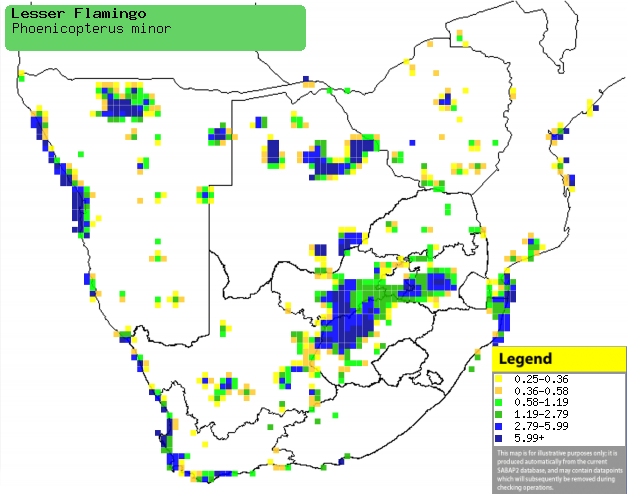|
Phoenicopterus minor (Lesser
flamingo)
Kleinflamink [Afrikaans]; uNondwebu [Zulu]; Kleine
flamingo [Dutch]; Flamant nain [French]; Zwergflamingo [German]; Flamingo-pequeno
[Portuguese]
Life
> Eukaryotes >
Opisthokonta
> Metazoa (animals) >
Bilateria >
Deuterostomia > Chordata >
Craniata > Vertebrata (vertebrates) > Gnathostomata (jawed
vertebrates) > Teleostomi (teleost fish) > Osteichthyes (bony fish) > Class:
Sarcopterygii (lobe-finned
fish) > Stegocephalia (terrestrial
vertebrates) > Tetrapoda
(four-legged vertebrates) > Reptiliomorpha > Amniota >
Reptilia (reptiles) >
Romeriida > Diapsida > Archosauromorpha > Archosauria >
Dinosauria
(dinosaurs) > Saurischia > Theropoda (bipedal predatory dinosaurs) >
Coelurosauria > Maniraptora > Aves
(birds) > Order: Ciconiiformes
> Family: Phoenicopteridae
Distribution and habitat
Occupies patches of India, Pakistan, the Arabian Gulf coast
and sub-Saharan Africa, isolated along the coast of West Africa but otherwise
occurring from Eritrea and Ethiopia through Kenya, Tanzania, Zambia and Angola
to southern Africa. It generally favours open, eutrophic and shallow wetlands,
coastal mudflats, salt works and sewage treatment plants; it exclusively breeds on salt pans and saline lakes.
|
 |
|
Distribution of Lesser flamingo in southern Africa,
based on statistical smoothing of the records from first SA Bird Atlas
Project (©
Animal Demography unit, University of
Cape Town; smoothing by Birgit Erni and Francesca Little). Colours range
from dark blue (most common) through to yellow (least common).
See here for the latest distribution
from the SABAP2. |
Movements and migrations
Its movements are fairly well understood. It
moves away from pans if they are flooded by a thunderstorm, often heading to the only large and regularly used
breeding sites in southern Africa: the Etosha Pan (Namibia) and Sua
Pan (Botswana).
Food
It exclusively eats cyanobacteria, such as Anabeana
and Naticula halophila, doing most of its foraging in shallow water with
its strangely-shaped bill upside-down. Its large tongue pumps water
through the filaments (lamellae) on the edge of its bill, which filter out the cyanobacteria.
Breeding
- Monogamous, colonial nester, breeding in roughly circular colonies
numbering in the tens of thousands. The entire group performs a spectacular
courtship display in which they all march in the same direction while
flapping their wings, outstretching their necks and waving their heads from
side to side.
- The nest is a simple, compact mound of mud on a flooded salt pan, with
the height varying from roughly 3-40 cm.
- It usually arrives at the Sua Pan in November and starts to
breed soon afterwards, while on the Etosha Pan it arrives breeding in
January and February. Breeding often continues in waves until August in both
Botswana and Namibia.
- It lays a single egg, rarely two, which is incubated by both sexes for
about 28 days in shifts of roughly 24 hours.
- The chick eats its own eggshell soon after hatching, leaving the nest at
about six days old to join a crèche of chicks of a similar age.Both parents
feed the chick with a secretion from their upper digestive tracts,
continuing to do so for
several months after hatching. Its feathers are fully developed by the time
it is 50
days old, fledging 20-40 days later.
Threats
Near-threatened globally, due to decreases in
populations across Africa, with a decrease of 27% in southern Africa between
1970-1994. The Sua Pan colony is seriously threatened by soda ash mining, which
lowers the water level. In Namibia, pesticides, increasing human population
and lowering water levels are the major threats. Colonies are highly sensitive
to disturbance, in fact smaller ones may be deserted because a plane flew over
too low.
References
-
Hockey PAR, Dean WRJ and Ryan PG 2005. Roberts
- Birds of southern Africa, VIIth ed. The Trustees of the John Voelcker
Bird Book Fund, Cape Town.
|
